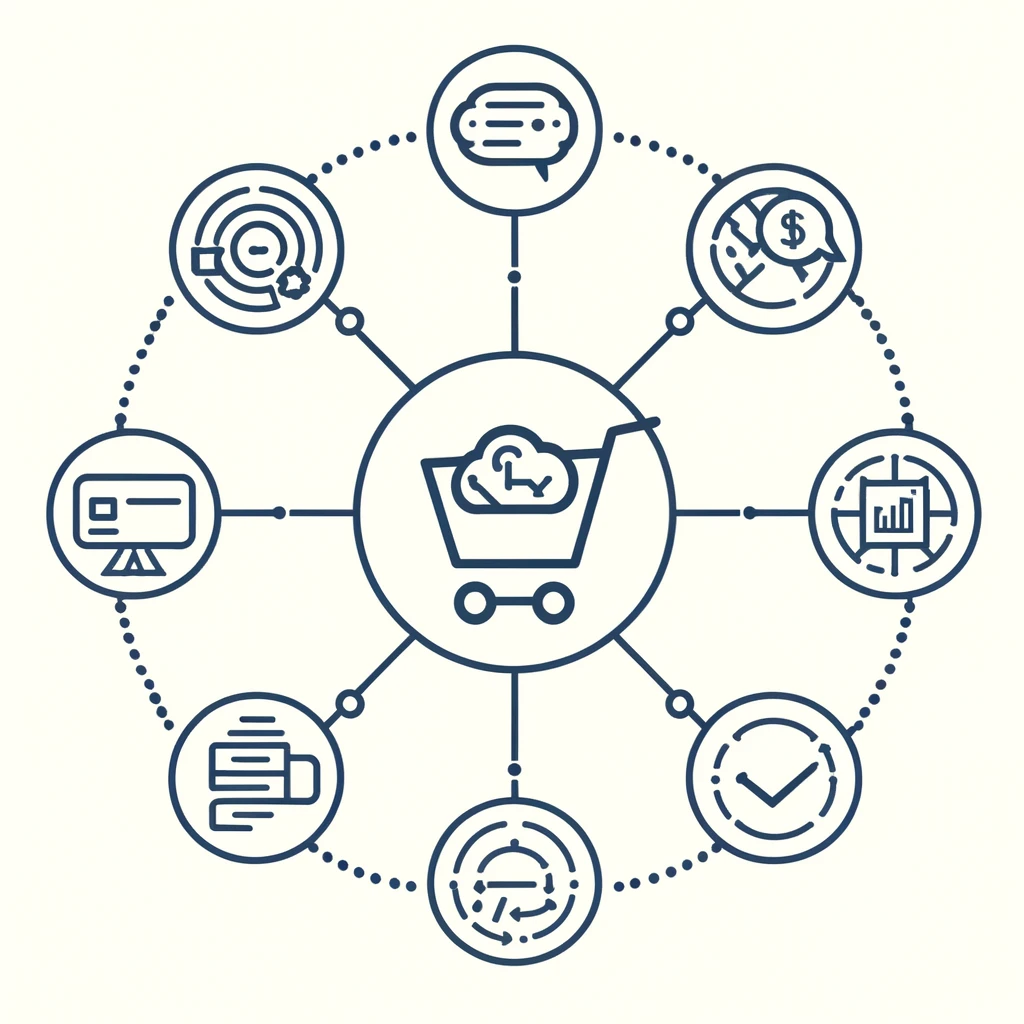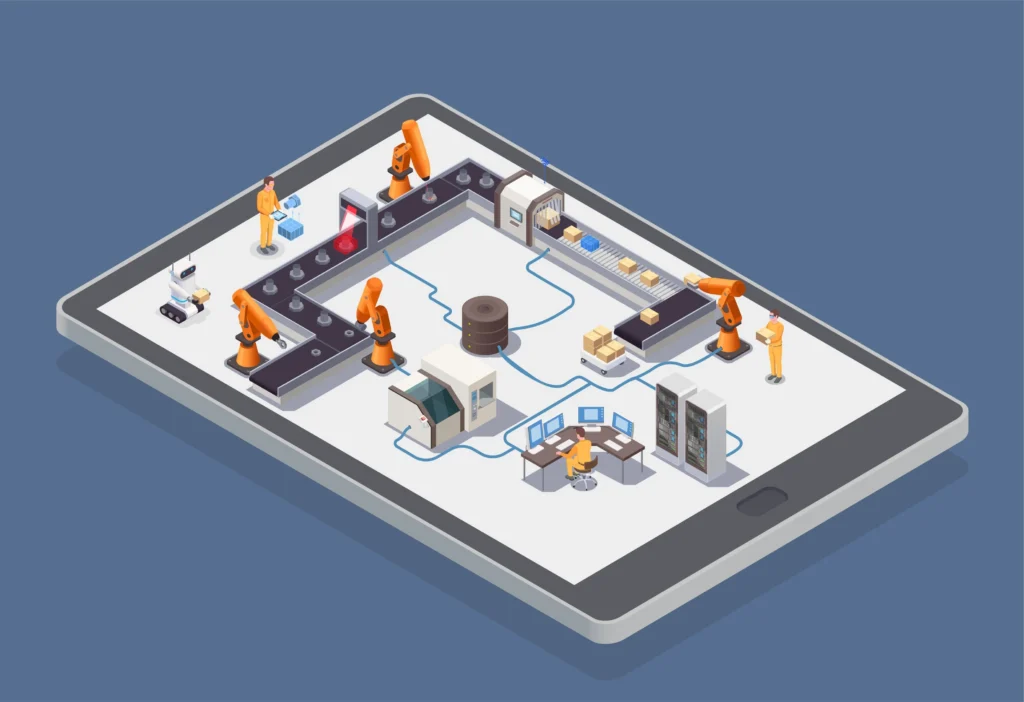Automation in E-commerce

Achieving Efficiency and Growth with AI Why has reliance on automation in e-commerce become vital for achieving efficiency and increasing productivity? Can automation transform routine operations into seamless and efficient processes, allowing companies to focus on innovation and providing better services to customers? In this article, we will explore how different stages of e-commerce can be automated using AI and available automation tools to answer these questions and more. Inventory Management: Inventory management is one of the most complex and time-consuming operations in e-commerce. Automation tools can make this process more efficient and effective. For example, platforms like Zapier and Make.com can link inventory management systems with order and sales systems. These tools can automatically update inventory levels upon completing a sale and issue alerts when product levels are low. Demand forecasting is another example of how automation can be used in inventory management. AI can analyze historical data and customer behavior to predict future demand. For instance, machine learning models can identify products likely to be in high demand in the future based on current trends and seasonal changes. This helps companies avoid overstocking or understocking. Customer Service: Providing excellent customer service is key to success in e-commerce. Automation tools can significantly improve customer experience by providing immediate and personalized support. AI-powered chatbots, like those offered by Drift and Intercom, can handle customer inquiries 24/7, professionally mimicking human interactions and providing instant and appropriate support. For example, an advanced chatbot can analyze customer inquiries and provide accurate and helpful responses. If a customer asks about the status of an order, the chatbot can access the order database and provide an immediate update. Additionally, the chatbot can handle return requests and issue clear instructions on how to return products, improving the customer experience and reducing the burden on the human support team. Marketing: Marketing is a crucial part of e-commerce, and automation here can be extremely effective. Marketing and customer relationship management tools can provide smart and efficient automation solutions. Tools like Mailchimp and HubSpot can automate email marketing campaigns, saving significant time and increasing campaign effectiveness. Personalized email campaigns are one of the main applications of this. AI can analyze customer behavior and preferences to create tailored marketing messages. For example, reminders can be sent to customers who left items in their cart without completing the purchase. Personalized promotional offers based on previous purchasing behavior can also be sent, increasing conversion likelihood. Social media management is another example of how automation can be used in marketing. Tools like Hootsuite can schedule social media posts and analyze audience engagement. These tools enable companies to publish content at optimal times and interact with their audience more effectively. Purchasing and Payment Process: Simplifying the purchasing and payment process can significantly enhance the customer experience and increase conversion rates. Automation tools, through integration with content management systems like Shopify and WooCommerce, can streamline the payment process and make it more secure while providing automated support to customers and vital payment data to the team simultaneously. Automated payment is a key example. With the use of gateways like Stripe and PayPal, the payment process can be simplified, and information accuracy can be automatically verified. In addition to providing a seamless customer experience, the system can send automatic reminders to customers who left items in their cart without completing the purchase, increasing conversion chances. More importantly, it can collect information from all payment gateways, organize it, and send it to the team automatically, saving significant time in reviewing transactions from each payment gateway. Order verification can also be a tedious and complex process, but automation tools can make it more efficient. The system can automatically verify order details and ensure data accuracy by setting specific standards and criteria for processing each order’s information, reducing errors and increasing order fulfillment speed. Returns and Refunds: Handling returns can be tedious and complex, but automation can simplify it significantly. Tools like Loop Returns can automatically process return requests. Returns processing involves issuing clear instructions to customers on how to return products. The system can verify the condition of the returned product and issue instructions for restocking or replacement. This improves efficiency and reduces the burden on the support team. Analytics can help improve the returns process. AI tools can analyze return data to identify common reasons for returns and improve product and service quality. This helps reduce return rates and increase customer satisfaction. Conclusion: Automation in e-commerce is not just a luxury but a necessity for improving efficiency and increasing productivity. From inventory management to customer service, marketing to shipping and delivery, automation can make a significant difference. Using AI-powered automation tools like Zapier, Make.com, and Mailchimp, companies can maximize their operations and improve customer experience. If you want to achieve efficiency and growth in your e-commerce business, automation is the optimal path to achieving that. Invest in smart tools and start transforming your operations as soon as possible.
Unveiling the Marketing 12 P’s: Expanding Your Marketing Mix

Introduction The traditional 4 P’s of marketing—product, price, place, and promotion—have long served as the foundation for marketing strategy. However, to create a more holistic approach, the marketing community has expanded upon this framework to include an additional 8 Ps. Collectively known as the “12 Ps of Marketing, these elements provide marketers with a comprehensive perspective on marketing strategy and execution. In this blog post, we will delve into each of the 12 Ps and explore their significance in shaping successful marketing campaigns. Conclusion: The 12 Ps of Marketing provide a comprehensive framework for marketers to consider and address various aspects of their marketing strategies and tactics. By incorporating these additional elements into your marketing mix, you can create more impactful and well-rounded campaigns. From product development and pricing strategies to distribution channels, branding, and customer experience, each P plays a crucial role in shaping successful marketing efforts. Embrace the power of the 12 Ps of marketing and unlock new opportunities for growth and differentiation in your industry.
Your Ultimate Customer Relationship Management Solution: Unlocking the Power of HubSpot CRM

Effective customer relationship management (CRM) is crucial for nurturing leads, boosting sales, and cultivating long-term customer loyalty in today’s fiercely competitive business environment. A variety of features in HubSpot CRM can help you streamline customer interactions and maximize your marketing efforts. In this blog post, we’ll examine HubSpot CRM’s main advantages and explain why it’s the best choice for companies of all sizes. One of HubSpot CRM’s most notable features is its free subscription plan, which comes with all of the necessary features. This enables companies to benefit from CRM’s power without paying additional fees. Access to necessary CRM features like contact management, email templates, live chat, and simple reporting is available with the free plan. Before thinking about the advanced features of paid plans, it’s a great way to get started and experience the advantages of HubSpot CRM. HubSpot CRM gives you the ability to combine emails, live chat, and social media messages into a single, centralized platform to unify your communication channels. This streamlines your communication processes, making it simpler to interact with customers, quickly address questions, and offer individualized support. All interactions are centralized for you. In addition to CRM features, HubSpot provides a number of marketing tools that work in unison with your CRM. From within the HubSpot platform, you can design landing pages, create email campaigns, automate marketing workflows, and monitor the success of your campaigns. Additionally, you can combine your Google and Facebook ad accounts, streamlining and maximizing your marketing expenditure. Holistic View of Customer Data: HubSpot CRM gives you the ability to compile and arrange vital customer data in a single hub. You can manage contact information, keep track of deal stages, manage interactions, and record notes and activities. You can comprehend your customers’ preferences, behavior, and history with your company thanks to this comprehensive view of customer data. With this knowledge, you can modify your sales and marketing tactics to cater to individual needs and foster closer relationships with clients. Advanced Reporting and Analytics: HubSpot CRM offers powerful reporting and analytics features that make it easier for you to assess the success of your sales and marketing initiatives. Key metrics can be tracked, including deal pipeline, email engagement, lead conversion rates, and customer acquisition costs. You can use these insights to optimize your sales and marketing procedures for better outcomes, identify areas for improvement, and make data-driven decisions. Workflow automation: With HubSpot CRM, you can speed up workflow by automating routine tasks. Workflow automation ensures consistency in your processes while saving time on tasks like sending personalized follow-up emails and task distribution to team members. This enables your sales and marketing teams to concentrate on high-value tasks like developing relationships, closing deals, and promoting company expansion. The HubSpot CRM platform integrates without a hitch with the company’s entire suite of tools, including HubSpot Sales, HubSpot Marketing, and HubSpot Service Hub. Through this integration, cross-team collaboration is made easier, productivity is increased, and a unified strategy for managing the entire customer lifecycle is offered. For companies looking to optimize their customer relationship management procedures, HubSpot CRM provides a complete solution. With its free subscription plan, unified communication channels, marketing tools, integration with ad accounts, thorough customer data management, advanced reporting, workflow automation, and seamless integration with other HubSpot tools, it empowers businesses to improve sales performance, foster long-term growth, and forge stronger customer relationships. Take advantage of HubSpot CRM’s power today to boost your CRM efforts.
Unlocking the Power of Flutter: A Game-Changer in App Development

Introduction Flutter has emerged as a powerful and popular framework for developing cross-platform mobile applications. With its unique features and close relationship with Google, Flutter has gained significant traction among developers and businesses alike. In this blog post, we will explore why Flutter is considered a game-changer in app development, its strong association with Google, and showcase some well-known apps built with Flutter. Conclusion Flutter has revolutionized the app development landscape with its exceptional performance, cross-platform capabilities, and strong integration with Google services. Its ability to deliver beautiful and customizable user interfaces, along with faster development cycles, has made it a go-to choice for many developers and businesses. With prominent apps like Google Ads, Reflectly, Alibaba’s Xianyu, and the “Hamilton” app showcasing its capabilities, Flutter has proven itself as a powerful framework for building top-notch mobile applications. Embrace the power of Flutter and unlock new possibilities in your app development journey.
Why Shopify is the Best Choice for Your Online Store

Introduction: The success of your online store depends on the platform you choose in the world of e-commerce. Shopify stands out among the many options as a top pick for business owners and entrepreneurs of all sizes. In this blog post, we will examine the reasons why Shopify is regarded as the best choice for starting and expanding your online store. Friendly User Interface: Shopify provides a user-friendly interface that makes creating and running an online store easier. Without any coding or design experience, even beginners can use its user-friendly dashboard to create a website that looks professional. You can easily alter the appearance and feel of your store to match your brand thanks to customizable themes and drag-and-drop functionality. Robust E-commerce Features: Shopify offers a full range of e-commerce features that enable you to successfully sell products. Shopify takes care of all the crucial facets of running an online store, from order fulfillment and inventory management to safe payment processing and shipping integration. It also supports multiple currencies, which is useful for businesses that operate internationally. Mobile-optimized and responsive: A responsive website that is mobile-optimized is essential in the era of mobile commerce. Shopify is aware of this and provides responsive themes that instantly adjust to various screen sizes, providing your customers with a seamless browsing experience whether they’re shopping on a desktop, tablet, or smartphone. App Store for Extensibility: Shopify’s App Store is a veritable gold mine of integrations and extensions that improve the functionality of your online store. To add features like email marketing, social media integration, customer reviews, loyalty programs, and more, you can pick from thousands of apps. With this flexibility, you can alter your store to suit the specific requirements of your company. Reliable and secure: For any online business, security comes first. You can relax knowing that your store is hosted on a safe and dependable platform with Shopify. Shopify handles server upkeep, security updates, and backups so you can concentrate on expanding your business without worrying about technical issues. Excellent Customer Support: Shopify provides first-rate customer support should you run into any problems or have inquiries while setting up or running your store. They have a committed support staff on hand around-the-clock via phone, email, or live chat, ready to help you whenever you need it. Scalability and Growth Possibilities: Shopify is made to grow along with your company. Shopify offers the infrastructure and tools to support your growth, whether you’re starting out small or have big growth plans. Shopify makes sure that your store can grow and prosper by managing increased traffic during busy times and integrating with cutting-edge analytics and marketing tools. Conclusion: Shopify stands out as the best choice for creating and managing an online store for numerous reasons. It is the perfect option for entrepreneurs and businesses looking to succeed in the cutthroat world of e-commerce thanks to its user-friendly interface, powerful e-commerce features, mobile optimization, extensive app store, security measures, excellent customer support, and scalability. Think of Shopify as your dependable partner in realizing your vision for an online store and advancing your company.
Unleashing the Power of AI Automation: Real-World Success Stories

Introduction: Automation powered by artificial intelligence (AI) has revolutionized business across industries, enabling new heights of effectiveness, productivity, and innovation. In this blog post, we will examine practical instances of AI automation in action, showcasing how forward-thinking businesses have benefited from these tools to produce outstanding outcomes. Businesses can learn about the transformative potential of AI automation and look into opportunities for their own expansion and success by studying these success stories. Customer Service Transformation: To revolutionize their customer service operations, international telecommunications company Verizon implemented AI automation in the form of virtual assistants and chatbots. Verizon was able to significantly cut response times and boost customer satisfaction by deploying AI-powered chatbots that could instantly and accurately respond to customer inquiries. Human customer service representatives were able to concentrate on more complicated issues due to the automation of routine tasks, which increased efficiency and improved the customer experience. Supply Chain Optimization: To streamline its supply chain operations, retail behemoth Walmart adopted AI automation. Walmart used machine learning algorithms to analyze enormous amounts of data in order to forecast product demand, optimize inventory levels, and boost supply chain effectiveness overall. Walmart was able to cut costs, reduce instances of out-of-stock merchandise, and guarantee that customers could access products whenever and wherever they needed them thanks to automation. The AI-powered supply chain optimization increased customer satisfaction while also increasing operational effectiveness. Marketing campaigns that are highly personalized: Netflix, an online streaming service, is well known for its highly customized recommendations and content suggestions. Netflix uses artificial intelligence (AI) automation to analyze user preferences, viewing habits, and historical data in order to provide its subscribers with tailored movie and TV show recommendations. Utilizing this automation, Netflix improves user interaction, boosts client retention, and stimulates content consumption. With the help of AI automation, Netflix is able to provide millions of users with a customized experience that keeps them interested in the platform and helps them find the content they love. Fraud Detection and Prevention: To effectively combat fraud, financial institutions like Capital One have embraced AI automation. Capital One analyzes customer transactions, patterns, and behaviors using machine learning algorithms to spot and stop fraud in real time. This automation greatly increases the accuracy of fraud detection, lowers false positives, and ensures that genuine customer transactions are not marked as fraudulent. Capital One protects customer assets, upholds customer trust, and reduces financial risks by using AI automation for fraud detection. Healthcare Diagnostics: By assisting in diagnosis and treatment planning, IBM’s Watson, a potent AI system, has significantly benefited the healthcare sector. Watson analyzes patient records, research articles, and medical data using AI automation to offer insightful analysis and suggestions to healthcare professionals. Doctors can create more individualized treatment plans, make more accurate diagnoses, and have better patient outcomes thanks to automation. In healthcare, combining AI automation with human knowledge improves precision, efficiency, and ultimately saves lives. Conclusion: These actual instances of AI automation show what a transformative effect these technologies can have on companies in a range of industries. AI automation is reshaping industries and spurring innovation in everything from customer service and supply chain optimization to personalized marketing campaigns, fraud detection, and healthcare diagnostics. Businesses can achieve new levels of efficiency, enhance customer experiences, and maintain their competitive edge by embracing AI automation and customizing it to their unique needs.
Streamlining Business Processes with AI Automation for Success

Businesses are constantly looking for ways to increase efficiency, cut costs, and deliver exceptional customer experiences in today’s fast-paced digital landscape. AI automation is one potent tool that is transforming how businesses run. Businesses can optimize operations, streamline processes, and seize new growth opportunities by utilizing the power of artificial intelligence. In this blog post, we’ll examine some of the most practical forms of AI automation for businesses and give examples of how they’re used in the real world. Automation using chatbots: Chatbots are AI-powered virtual assistants that can converse with customers and offer prompt assistance. They are a great tool for streamlining sales, lead generation, and customer service operations. For example, an e-commerce company can use a chatbot to respond to frequently asked questions, help customers find products, and even facilitate transactions on their website. While ensuring that customers receive prompt and individualized assistance, automation helps save time and resources. Automation through artificial intelligence (AI) can be used to efficiently and broadly produce content. A blog post, a product description, or a social media caption can all be produced by natural language processing (NLP) algorithms after data analysis. This kind of automation allows businesses to consistently produce high-quality content, which is especially advantageous for sectors with a high content consumption rate. Marketing Automation: AI enables companies to deliver marketing experiences that are specifically catered to the preferences and behaviors of each individual customer. Businesses can segment audiences, analyze customer data, and execute targeted marketing campaigns by utilizing machine learning algorithms. An online retailer, for instance, could use AI automation to send customers personalized product recommendations based on their past purchases, browsing patterns, and preferences. Increased customer engagement, higher conversion rates, and increased sales are all benefits of this level of personalization. Predictive analytics: Predictive analytics analyzes large datasets and provides precise forecasts of future events using AI algorithms. Utilizing automation, businesses can improve decision-making, predict customer behavior, and spot trends. For instance, based on customer information, an insurance company can use predictive analytics to evaluate risks and determine the appropriate premiums. Process automation: AI automation can speed up time-consuming and repetitive tasks in a variety of business functions. Businesses can automate procedures like data entry, document processing, and inventory management in areas like finance and human resources, as well as supply chain management and operations. Because of the automation, employees can concentrate on more strategic initiatives that call for human creativity and decision-making while also reducing errors and increasing efficiency. In conclusion, businesses looking to streamline operations, enhance customer satisfaction, and gain a competitive edge can greatly benefit from AI automation. Numerous forms of AI automation, including chatbot automation, content generation, personalized marketing, predictive analytics, and process automation, have the potential to completely transform the way businesses run. Businesses can improve productivity, spur growth, and prepare for a prosperous future in the digital age by embracing these technologies and utilizing their capabilities.

